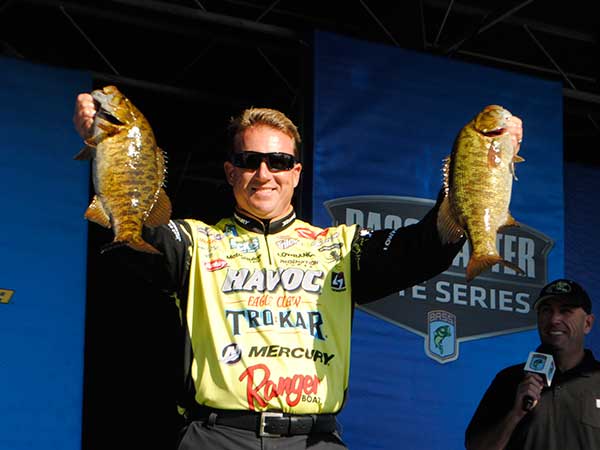(Provided by Michigan DNR)
 Skeet Reese with Escanaba BassESCANABA, Mich. - Mention Lake Michigan's Bays de Noc to most anglers and they'll immediately start talking about fishing for walleye.
Skeet Reese with Escanaba BassESCANABA, Mich. - Mention Lake Michigan's Bays de Noc to most anglers and they'll immediately start talking about fishing for walleye.
But in the wake of September's high-profile Bassmaster Angler of the Year Championship - which brought 50 of America's top anglers to Escanaba to ply the waters of Big and Little Bays de Noc - what was once seemingly relegated to "also-ran" status is now national news: The Bays are loaded with trophy bass, too.
"The fishery has always been kind of walleye-centric," said DNR fisheries biologist Darren Kramer. "Bass is kind of an up-and-coming, emerging fishery. Every year we see more and more bass boats, and more out of state anglers, taking advantage of the fishery. There's a lot of traffic out on Big Bay de Noc after the bass opener. That fishery's really taken off in the last five or six years."
"Our creel data indicates there's increasing angler effort and we think that's attributable to bass," Kramer continued. "Bass harvest has stayed the same, but use of the resource is going up along with angler success, which implies we're recruiting more catch-and-release bass anglers to the area."
The Bassmaster Angler-of-the-Year Championship started with a bang: On the first day, 12 competitors brought in five-fish limits with a total weight in excess of 20 pounds.
Catching bass that weigh more than four pounds each isn't often accomplished in tournaments, even on some of America's best big-bass lakes.
Although the tournament hit a minor snag, with high winds causing delays that shortened the event to two days rather than three, the weather couldn't dampen the enthusiasm of the competing pro anglers who described the fishery as "awesome," "incredible," "unbelievable" and "amazing."
Paul Elias, a Laurel, Mississippi, resident who won the BASS Classic in 1982, was effusive in his praise.
"It's as good as, or better than, any smallmouth fishery we fish," he said. And Elias' comments were echoed by virtually all the competitors.
Fayetteville, Tenn. bass pro Brandon Lester, who brought in the biggest bass of the first day's competition ñ a six-pound, four-ounce smallmouth, said, "I've never seen so many big smallmouths in my life. They're not everywhere, but when you find one, you'll find a group of them. When you get around them, you can light them up real quick."
Said Skeet Reese, a top angler from Auburn, California, at the weigh-in: "That's the best day of smallmouth fishing I've ever had in my life. This is an incredible fishery."
While many of the anglers were surprised by the quality of the fishery, Kevin Short of Mayflower, Arkansas, said the results were just what he expected.
Short first fished the waters off Escanaba in 2008 when he recognized that the area would undoubtedly host a future tournament, and has come back every year since just to fish for fun.
"If there's any place in the whole country we would move to for nine months of the year, this would be it," Short said. "The first couple of trips we really didn't catch that many, but once we figured it out, holy smokes. It's a really special place. I'd drive 18 hours just to come up here and fish a few days."
Scott Cormier, a 42-year-old recreational vehicle salesman and lifelong bass angler from Gladstone, said the tournament was "going to open up a lot of eyes" across the country.
"There's a big deep-water fishery out there that nobody's really fishing," Cormier said. "There are fish out there in 40 feet of water that have never seen a lure before."
Indeed, most of the anglers were fishing shallow water during the tournament, concentrating on the rocky shoals that were only a few feet deep on the top or on the weedy flats adjoining drop-offs.
Dan Anderson, a 48-year-old maintenance supervisor from Fond Du Lac, Wisconsin, who fishes Bays de Noc regularly and was on hand to take photographers out on the lake during the tournament, said the fishery is capable of yielding 100-bass days at any time.
"They're biting good by opening day," he said. "You can catch them by May 1st and fish right up to deer season."
That such an outstanding bass fishery flew under the radar for so long is just a matter of the Upper Peninsula fishing culture, Kramer said.
"Many anglers in the U.P. are typically looking for panfish or walleye," Kramer said. "A lot of the bass fishermen we see are from downstate or out of state. But I predict that might begin to change."
Added Jessica Mistak, the DNR's fisheries management supervisor for northern Lake Michigan: "We think this is a world-class fishery that's really been overshadowed by the walleye fishery. Now that anglers see that there are fish to catch other than walleyes in the Bays, they'll be eager to come here and try it."
Although invasive species are typically talked about in a negative light, Mistak said water clarity changes ñ brought on by zebra and quagga mussels ñ and new prey species, such as gobies, may have helped the smallmouth population.
Certainly, the smallmouths are thriving, a fact that is not so secret any more.